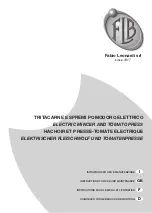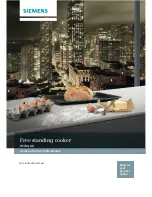
29
Accessories
• Only use original Rommelsbacher bags/rolls with groove texture. The following accessories can be
purchased from your specialist shop:
Foil bags
Foil rolls
VBS 203 – 50 pcs. à 20 x 30 cm
VRS 1560 – 2 pcs. à 15 x 600 cm
VBS 304 – 50 pcs. à 30 x 40 cm
VRS 2060 – 2 pcs. à 20 x 600 cm
VRS 3060 – 2 pcs. á 30 x 600 cm
Please find further accessories for vacuuming food in containers in specialist shops, at the internet or just visit
our website www.rommelsbacher.de
Tips for vacuum sealing
• When vacuuming food with tapered ends or sharp edges, like bones and dried pasta, pad the edges with
paper towels to prevent perforating the bag.
• In order to avoid the intake of liquids when vacuuming very damp food (e. g. meat or blanched vegetables),
you can additionally wrap those in in cling film or place a kitchen tissue inside the bag at the open edge so
that escaping liquid is soaked up.
• Once perishable food has been packed, place it in the fridge or freezer immediately.
• Place the packs of vacuum-sealed food evenly in the fridge or freezer so that the food will cool down rapidly.
• After opening tinned food or food that has been factory vacuum-sealed, it can be vacuum-sealed again.
Follow the instructions for repacking pre-packed food and for freezing the food as described.
• Pre-packed food must in any case be consumed by the “use-by date” shown on the original package.
• Once you have warmed up or defrosted perishable food, it must be eaten. Do not eat perishable food if it has
been left at room temperature for many hours. This is especially important if the food has been prepared with
a thickened sauce or are in low-oxygen content environments (like e. g. in a vacuum).
• Do not defrost food in boiling water or using other heat sources, unless the food in question is liquid (soups,
juices, etc.).
• Vacuum sealing extends the storage period of dried food. Food which has a high fat content quickly becomes
rancid due to oxygen and heat. Vacuum sealing also extends the storage period of food like nuts, coconut
flakes or grain varieties. Store these in a cool, dark place.
• Fruit and vegetables like e. g. apples, bananas, potatoes, etc. must be pealed prior to vacuum-sealing.
• Soft foods and food with a delicate structure (like fish, berries, etc.) should be pre-frozen for one night before
they are vacuum-sealed and placed in the freezer again. .
• Vegetables like e. g. broccoli, cauliflower and other cabbage discharge gases when they are vacuum-sealed
freshly for storage in the fridge. Therefore blanch these foods before vacuum-sealing and then store them in
the freezer.
• There are many non-food products which can be protected by vacuum-sealing, such as camping equipment
including matches, first aid kits and clean, dry clothes. You can even preserve the emergency triangle in the
car. Also, you can extend the storage time of pipe tobacco. Silverware and collections can also be vacuum-
sealed to protect these items against oxidation.




































